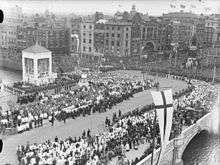Eucharistic Congress of Dublin (1932)
The 31st International Eucharistic Congress, held in Dublin 22–26 June 1932, was one of the largest eucharistic congresses of the 20th century.

Ireland was then home to 3,171,697 Catholics. It was selected to host the congress as 1932 was the 1500th anniversary of Saint Patrick's arrival. The chosen theme was "The Propagation of the Sainted Eucharist by Irish Missionaries."[1] Two days before the Congress, Time Magazine noted the Congress' special theme:
Previous Congresses have had their characteristic notes, wrote Managing Editor Vincent de Paul Fitz-patrick of The Catholic Review. In Chicago there was the "enthusiasm of the Americans"; in Rome "the everlasting glory of the church"; in Spain "the love of beauty and gallantry of the Spanish"; in Carthage "the memory of the martyrs." In Dublin, undoubtedly, it would be "the Faith of the Irish."[1]
Seven ocean liners moored in the port basins and along Sir John Rogerson's Quay. These were De Grasse, Doric, Dresden, Duchess of Bedford, Marnix van Sint Aldegonde, Rio Bravo and Sierra Cordoba. Five others, Antonio, Laconia, Lapland, Samaria and Saturnia anchored around Scotsmans Bay. The liners acted as floating hotels and could accommodate from 130 to 1,500 people on each.
The final public mass of the congress was held in Phoenix Park at an altar designed by the eminent Irish Architect John J. Robinson of Robinson & Keefe Architects, at 1pm on Sunday, and was celebrated by Michael Joseph Curley, Archbishop of Baltimore. John Mc Cormack the world famous Irish Tenor sang at the mass. Approximately 25% of the population of Ireland attended the mass and afterwards four processions left the Park to O'Connell Street where approximately 500,000 people gathered on O'Connell Bridge for the concluding blessing given by the Papal Legate, Cardinal Lorenzo Lauri. The Dundalk Democrat described the event:
Here men and women are proud to give evidence of their Faith: proud of being sons and daughters of the dead and gone Catholics who kept the flame alive in evil days of persecution and spoliation. ...The men and women of long ago... from the high place in Heaven won by their heroic piety... must have looked down upon this glorious scene with serene happiness and benediction.
The English Catholic writer G. K. Chesterton was also present, and observed:
I confess I was myself enough of an outsider to feel flash through my mind, as the illimitable multitude began to melt away towards the gates and roads and bridges, the instantaneous thought "This is Democracy; and everyone is saying there is no such thing."
See also
References
- 1 2 "In Dublin". Time Magazine. 1932-06-20. Retrieved 2008-06-22.